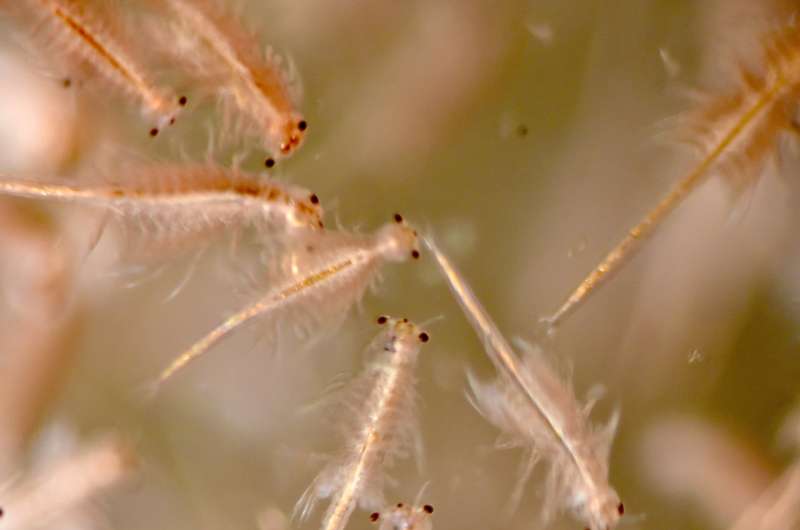Researchers find that swarms of tiny organisms mix nutrients in ocean waters

Swarms of tiny oceanic organisms known collectively as zooplankton may have an outsize influence on their environment. New research at Stanford shows that clusters of centimeter-long individuals, each beating tiny feathered legs, can, in aggregate, create powerful currents that may mix water over hundreds of meters in depth.
Although the work was carried out in the lab, the finding is the first to show that migrating zooplankton – or indeed any organism – can create turbulence at a scale large enough to mix the ocean's waters. The work could alter the way ocean scientists think about global nutrient cycles like carbon, phosphate and oxygen, or even ocean currents themselves.
"Ocean dynamics are directly connected to global climate through interactions with the atmosphere," said John Dabiri, a professor of civil and environmental engineering and of mechanical engineering. "The fact that swimming animals could play a significant role in ocean mixing – an idea that has been almost heretical in oceanography – could therefore have consequences far beyond the immediate waters where the animals reside."
Dabiri, who was senior author on the work published April 18 in Nature, added that the findings could also help scientists understand how the ocean sequesters carbon dioxide from the atmosphere and lead to updates in ocean climate models.
"Right now a lot of our ocean climate models don't include the effect of animals or if they do it's as passive participants in the process," Dabiri said.
Churning waters
One of the most common zooplankton, krill are among the most abundant marine organisms and migrate daily in giant swarms, heading hundreds of meters deep by day and up to the ocean's surface by night to feed.
Dabiri knew that in terms of forces that drive the mixing of oceans, wind and tidal currents are thought to play the largest role. But he wondered if giant zooplankton migrations could also be involved – an idea first proposed by oceanographer Walter Munk in 1966, and since then debated but never systematically explored.
Dabiri and graduate student Isabel Houghton tried to answer that question not in the ocean but in the relatively controlled environment of large water tanks in the lab. The pair worked with Jeffrey Koseff and Stephen Monismith, professors of civil and environmental engineering who are experts on mixing in the ocean, to create flow environments that mimic the ocean with saltier water on the bottom of the tank and less salty water on the top. The resulting gradient mirrors ocean conditions that any organism would need to disrupt in order to cycle nutrients between the ocean's surface and water deep below.
"There's no appreciable deep mixing of oxygen or carbon dioxide in the ocean if you can't overcome the stabilizing influence of salinity and temperature gradients," Koseff said.
In the lab, the group was looking to see whether the tiny organisms they studied – mostly brine shrimp (also known as sea monkeys) as a stand-in for less lab-hardy krill – are simply churning water locally, leaving the gradient intact, or redistributing salt into a more uniform mixture. If they can mix layers in the lab, chances are they can do the same in the ocean, the group argued.
Swimming by laser light
To carry out the study, Houghton placed brine shrimp in the tank and activated laser or LED lights from either above or below, because brine shrimp are attracted to light, so they migrated toward the source. When she reversed the lights the tiny creatures scurried to the other end in a migration that lasted about 10 minutes.
With cameras closely recording the animals' movements, the group has been able to measure the individual water eddies surrounding each brine shrimp and the larger currents in the tank. From these, they've shown that turbulence from individual organisms aggregates into a much larger turbulent jet in the wake of the migration.
What's more, those flows were powerful enough to mix the tank's salt gradient. "They weren't just displacing fluid that then returned to its original location," Houghton said. "Everything mixed irreversibly."
Before this work, scientists had thought that krill and other zooplankton could only create turbulence in their own size range – on the order of centimeters. That's hardly enough to move nutrients on a meaningful scale. Now it appears that zooplankton have the capacity to mix ocean waters, at least regionally. Furthermore, Dabiri said their findings might not just apply to organisms like krill in the upper kilometer of the ocean, but also to jellyfish, squid, fish and mammals that swim even deeper, potentially churning the entire water column.
Dabiri said his lab members need to verify their findings in the ocean, which will involve finding and following swarms of krill in locations as diverse as the California coast and frigid Antarctic waters. But if they continue to see mixing at the scales the lab work suggests, the findings could change the way ocean scientists think about the role of animals in influencing their watery environment – and potentially our climate on land.
Starting simple for big results
Despite the work's potential impact in how ocean scientists think about the role of marine animals on global issues like climate and nutrient cycles, this research has a storied past. Its funding was once featured in a list of government waste known as The Wastebook, which referred to it as studying synchronized swimming in sea monkeys.

"By starting simple and using an unorthodox organism like the brine shrimp, it has allowed us to now go into the ocean and measure something where we have a more specific target in mind," Dabiri said.
Measurements that would have cost $20,000 per day on board a ship cost only about $100 per day in the lab, saving significant money and producing results that are relevant for scientists and policymakers alike.
More information:
Vertically migrating swimmers generate aggregation-scale eddies in a stratified column, Nature (2018).
nature.com/articles/doi:10.1038/s41586-018-0044-z
Journal information: Nature
Provided by Stanford University



















